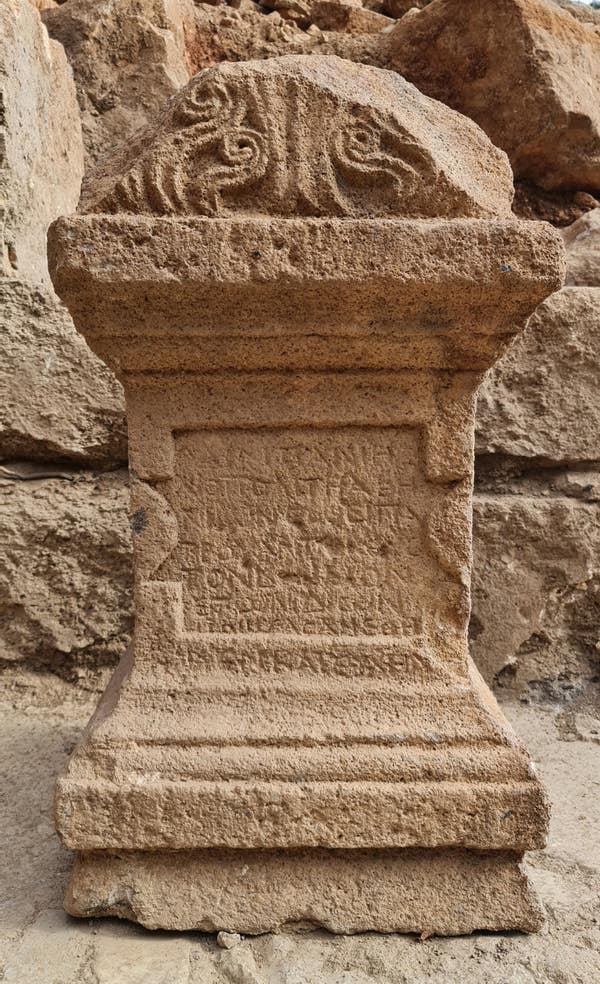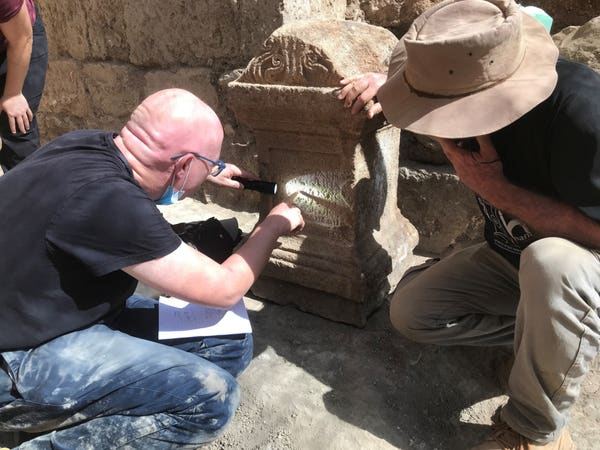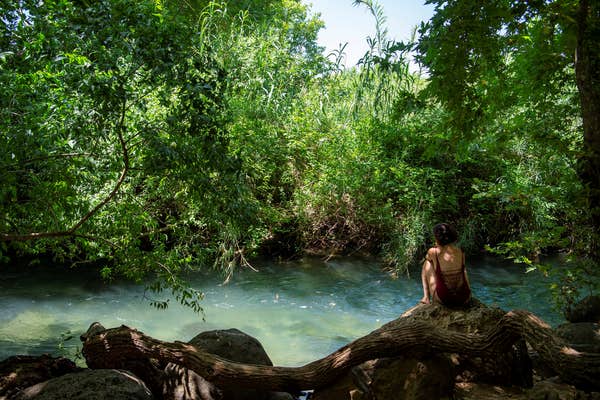
An Israeli archaeologist uncovered a remarkable find in the ruins of a Byzantine church in Israel recently when a stone altar to the Greek God Pan Heliopolitanos was unearthed during excavations there.
Located in the Banias region of the country — the name originating from an Arabic transliteration of the Greek god’s name — the church had long ago fallen into ruin but was protected due to being surrounded by a nature sanctuary.
Archaeologist Adi Erlich made the stunning discovery as the walls of the structure were gradually uncovered, according to a report from Haaretz. The altar, showing carvings of a Greek deity which has aspects of both Pan and Zeus, dates back to 1,800- 1,700 years before present and had been made part of the church’s wall when it was built in the seventh century, according to Erlich.

She states that this may have been done just for expediency, as it was common in older times to reuse the remains of any older structure, including pagan temples, in religious or secular buildings. Indeed, she adds, the small temple, with its carvings defaced, may even have been utilized as a way to show that Christianity had triumphed over paganism.
In any event, the writing dedicating the altar to Pan/Zeus had been turned to the outside so it would not be seen by Christian worshipers.
The temple was created during the Roman period in Israel and the church was built at the very end of the Byzantine period in the country, which may mean that the temple may have been dislocated from its original site for some time before the church was constructed.
Greek altar found in nature reserve in Israel

Erlich, from the Zinman Institute of Archaeology at Haifa University, is the co-director of the church excavation project, along with Ron Lavi.
It is well-known that the verdant nature reserve, part of the Israel Nature and Parks Authority, has been a sacred site for different religions over the millennia. Erlich explains that the fact that the entire area is called the “Banias,” denoting Pan, means that it was considered a sacred place for the different religions, beginning in pagan times — and that led ultimately to its preservation over all these years.
This is the second church discovered so far on a previously pagan sacred site in the Banias, located in the north of Israel.

Erlich explains that the altar stone was not difficult to pick out amongst all the other stones of the church wall.
“The wall is made of small simple stones and there’s this one great big stone,” she says, while all the other stones used in the building are either travertine or limestone.
The altar stone, which is a full meter in height, had been carved out of local volcanic basalt rock. The basalt may have come from the Golan Heights area, which was a volcanically-active area 100,000 years ago.

In total, there were four altars found by the team during their excavations — three plain stones without inscriptions, then this spectacular carved altar stone. All were from the Roman period of Israeli history.
Thinking originally that this was just another reused stone, the archaeologists turned it around and stood it up to get a better look at it — and only then did they see that it had been inscribed, according to Erlich.
“On its front is an inscription encompassed in a frame, in Greek – the lingua franca here during the Roman period,” she says, explaining that the most common languages of the local people were Greek and Aramaic while only officials and soldiers spoke Latin during that period.

In a charmingly endearing twist, the archaeologists saw that the writing on the altar had clearly been inscribed by a workman who was not exactly an expert — as the text starts out quite large, but as the carver realizes he is going to run out of space, the words become much smaller and almost run off the edges of the stone.
“It seems they didn’t plan their space very well,” says Abner Ecker of Bar-Ilan University in Ramat Gan, Israel. “The inscriber was no pro.”
The archaeologist is still analyzing the stone’s inscriptions. As he told Haaretz, basalt is an excellent stone for inscribing and the stone’s markings have survived so well due in part to this — as well as the action of the church builders, who had oriented the stone away from the inside of the building.
Ecker says that ancient inscriptions such as the one found on the Banias Pan/Zeus stone follow certain formulas.
“Somebody not acquainted with the formulae might not realize what words to look for, which makes reading harder. You read letter by letter and then put it together – it’s usually not so well preserved as to read it just at one go,” he explains.
As was true with all writing from ancient times, there is no punctuation.
Possible religious pilgrimage dedication on Greek Altar in Israel
According to Erlich, the inscription goes as follows: “Atheneon son of Sosipatros of Antioch is dedicating the altar to the god Pan Heliopolitanos. He built the altar using his own personal money pursuant to a vow he made.”
The man’s name, cited along with his father’s, as well as the intention to use his wealth to construct the altar, is part of the usual formulae seen in nearly all such ancient inscriptions. But the remarkable aspect of this stone is that the man who dedicated it was a traveler from very far away.
From Antioch, in today’s Turkey, Atheneon hailed from a city that was far to the north (and one that was to figure centrally in the development of Christianity much later). Situated 332 kilometers (206 miles) from the Banias, this man had clearly been on some kind of a mission resulting in the creation of the altar.
Indeed, Erlich says that this may have been a kind of pilgrimage, since the cult of Pan was extremely popular and the Banias appeared to be dedicated to, and named after, the god.
Of course, it is impossible to know if this was the ultimate destination for the traveler Atheneon or whether he had simply been going through the area on some other type of trip. However, the Banias (called “Paneas”) is referenced in several ancient sources outside of the Bible, so it is not unthinkable that this was a religious pilgrimage for him.
Intriguingly, it is not expressly stated exactly what Atheneon vowed. But Ecker says that considering the man came from Antioch, which was the third-largest city in the Roman Empire at the time — after Rome and Alexandria — and he had made it that far on his journey, he may simply have been thanking his favorite god for having made it safely to that point.
Another unusual aspect of the find is that there may have been a syncretization of religious beliefs occurring in the altar. “That’s the most intriguing thing about the inscription: the syncretism of gods and religions. Heliopolitanos is a name usually associated with Zeus, not Pan,” Erlich says.
Pan, the Greek god of shepherds, was a known deity of the ancients all around the Mediterranean for thousands of years. In fact, an amazing gold mask of the god was unearthed at Israel’s town of Hippos, overlooking the Sea of Galilee.
Pansyncretization Very Common
However, the god referred to as Zeus Heliopolitanos, or Jupiter Heliopolitanos, was how Zeus was commonly referred to along the southern shores of the Mediterranean, including Syria to northern Israel. His cult had its center at Heliopolis, the town named after him, which later became known as Baalbek, in today’s Lebanon.
Roman soldiers were particularly devoted to Zeus/Jupiter, according to Erlich, with the high point of his worship occurring during the first and second centuries AD.
“For the pagans, a god wasn’t static and holistic,” Erlich explains. “The inscription is dedicated to a combination of Pan and a facet of Zeus. Not Heliopolitan Zeus, but a sort of combination of Pan and this aspect of Zeus.”
Of course, as Erlich notes, the Acropolis itself shows two different aspects of the goddess Athena — Athena Parthenos, or the Virgin Athena, which is no longer there; alongside the temple of Athena Nike, or Athena Victorious, which was built at the entrance to the Acropolis.
The Banias was also the site of another discovery some time ago showing a syncretization of Pan and Zeus, according to Ecker, so the recent discovery is just additional proof that this practice existed and was widespread, including that at Baalbek.
He goes on to say that there are many such instances in the archaeological record. “We have seen similar things in the Alps – for instance, dedications to ‘Jupiter of the Alps’ thanking the god for success in travel, and in Israel, where inscriptions were found in the Judean Desert and in Machtesh Ramon, thanking the gods for success in travel. That is a theory of the vow Atheneon made.”
“Here they worshipped Aphrodite”
Interestingly, Erlich adds that the local people never seemed to adopt the Roman versions of the Greek gods, despite the overwhelming Roman domination and presence in the area which happened in later times. “Here they worshipped Aphrodite, not Venus, for instance,” she explains.
Further ties to the Greek world were noted by Erlich, as she says that this same area was the site of the well-known and recorded “Battle of Panium” between the Ptolemaic regime and the Seleucids in 200 BC.
This famous clash took place near the Banias spring, with the Seleucids gaining the area after the defeat of the Ptolemaic forces.
Continuing to serve as a center for religious worship, it was recorded that the Banias was where King Herod built an altar to his patron, Caesar Augustus, according to the historian Josephus.
After this powerful king died in 4 BC, rule over the Banias fell to his son, Herod Philip. He later made it into a city called Caesarea Phillippi — which was even prominently mentioned in the New Testament.
Although Josephus referred to the city as Caesarea Paneas, it was undoubtedly the same city, which the disciples St. Mark and St. Matthew mention in their Gospels.
“When Jesus came to the region of Caesarea Philippi, he asked his disciples, ‘Who do people say the Son of Man is?’ They replied, ‘Some say John the Baptist; others say Elijah; and still others, Jeremiah or one of the prophets.’ ‘But what about you?’ he asked. ‘Who do you say I am?’ Simon Peter answered, ‘You are the Messiah, the Son of the living God’” (Matthew 16:13-16).
The area may even have been the site of the building of a church, after the explicit direction of Jesus to do just that, in the Gospel of Matthew.
“On This Rock I Will Build My Church”
“Jesus replied, ‘Blessed are you, Simon son of Jonah, for this was not revealed to you by flesh and blood, but by my Father in heaven. And I tell you that you are Peter, and on this rock I will build my church, and the gates of Hades will not overcome it.’” (Matthew 16:17-18).
At this point, Erlich notes, the exact location of Herod’s temple to Caesar Augustus is still unknown. There are no signs of such a building at the Banias site, with even the altar having been made 200-250 years after Herod’s time.
However, the ruins of the church with the Pan/Zeus altar stone still lie in the Banias. It is the second church on the site, as the first, known to have been built in the fifth century, was destroyed due to an earthquake.
See all the latest news from Greece and the world at Greekreporter.com. Contact our newsroom to report an update or send your story, photos and videos. Follow GR on Google News and subscribe here to our daily email!



